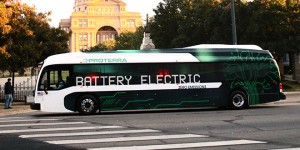Tesla’s master plan foresees electric buses but also autonomous, smaller mini-buses that can serve people on demand and take them right to where they want to go:
With the advent of autonomy, it will probably make sense to shrink the size of buses and transition the role of bus driver to that of fleet manager. Traffic congestion would improve due to increased passenger areal density by eliminating the center aisle and putting seats where there are currently entryways, and matching acceleration and braking to other vehicles, thus avoiding the inertial impedance to smooth traffic flow of traditional heavy buses. It would also take people all the way to their destination. Fixed summon buttons at existing bus stops would serve those who don’t have a phone.
This development is significant for two reasons. First, the push into the bus realm helps overcome some of the tension between electric vehicles and transit advocates. The electrification of transportation, as I’ve written before, reduces pollution from vehicles and also undermines the pro-transit argument that more buses and trains offsets pollution from gas-guzzling passenger vehicles. So if Tesla is improving transit vehicles, that gives anti-car, pro-transit advocates a reason to like the company.
Second, Tesla’s automated driving technology could greatly improve the service of transit. What bus user wouldn’t love transit on-demand that gets you right to where you want to go?
But some transit advocates aren’t buying it. Jarrett Walker at Human Transit thinks Musk’s vision will bump up against a “geometry problem”:
But when we get to dense cities, where big transit vehicles (including buses) are carrying significant ridership, Musk’s vision is a disaster. That’s because it takes lots of people out of big transit vehicles and puts them into small ones, which increases the total number of vehicles on the road at any time. The technical measure of this is Vehicle Miles (or Km) Travelled (VMT).
He bristles at the idea that technology boosters like Musk want to do away with the traditional fixed-route bus, which underpins mobility in dense urban environments.
But Walker never acknowledges that Musk does in fact address the “geometry” problem: automated mini-buses, in a world of all autonomous vehicles within dense city centers, will have the ability to “platoon” — essentially tailgate on steroids. Since the vehicles are all communicating with each other, they can drive bumper to bumper like train cars, freeing up a huge amount of street space.
Or as Musk writes, these mini-buses will be “matching acceleration and braking to other vehicles, thus avoiding the inertial impedance to smooth traffic flow of traditional heavy buses.”
I’m not an engineer, so I can’t say definitively that the gains in street space from platooning will offset the increase in vehicle traffic from mini-buses. But theoretically, it seems to me that we can achieve Musk’s vision and still have the dense urban environment and mobility of fixed-route buses, as Walker advocates.
All of this is still a ways off in the future, but not as far as many people might think. If Musk is correct on the timing, it could happen with the next decade. At that point, we may all be in electric vehicles, even if we live in a dense city and never drive a car.
Leave a Reply
You must be logged in to post a comment.



